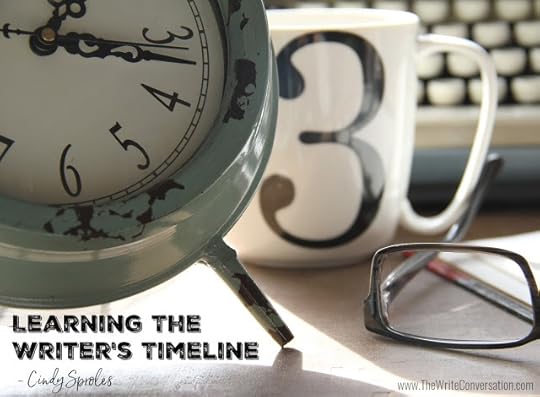Learning The Writer's Timeline

by Cindy K. Sproles @CindyDevoted
My publisher’s editors will tell you, I’m lousy at timelines. It’s become somewhat of a joke with them. A writer friend once told me the sign of a good author was when you could openly admit to your writing weaknesses. I recall asking if she had a couple of hours to listen but I digress.
I’ve sat across the appointment table numerous times as new authors present their novel or non-fiction book. When I ask if their manuscript is complete, they turn pale. That forces me to say, “I need a finished manuscript.” When new writers hear these words, their enthusiasm melts into a puddle of liquid before my eyes and I feel like I have personally destroyed their life’s career.
Fifteen-minute appointments are wonderful. They’re an opportunity for writers to ask questions to industry professionals as well as a prime opportunity to pitch their work. Let’s look at the writer’s timeline. Here are four steps of a writer’s timeline:Learn the craftWrite the manuscriptEdit and polishPitch to an agent or publisher
These items should not be switched, yet I continually hear, “But I can pitch this to an editor or an agent now.” Yes, you can, but my rebuttal is simple. Can you make brownies without an egg?
Let’s Address Our Writer’s Timeline
Steps 1 & 2: Learn the craft and get that manuscript on paper: This is a must. If you’d like to see an industry professional bang their head on the table, tell them you were told you didn’t need to write the book first. Let’s clear this misnomer quickly. If you are a DiAnn Mills, Bob Hostetler, or Steven James who has numerous books already in print, your publisher will look at a proposal and three chapters of an unfinished work and either accept or decline the manuscript based on their current needs because they know you can turn out work that is ready for publication. They already have sales histories and relationships with readers. Rarely, will an industry professional sign a deal on a new author based on a non-fiction outline of chapters and a proposal or a fiction synopsis and three chapters of an unfinished manuscript.
Here’s why. It’s not that you do not have a great idea. The idea may be awesome but industry professionals need to see that an author can write a book from beginning to end. I learned the hard way as a new acquisitions editor. I found a writer with a super story that came to me as a proposal and 3 chapters. The chapters were well done, beautifully executed, so we offered a contract. That’s when the editor contacted me to let me know, the manuscript was a disaster. It didn’t follow any sort of thought process. The help the author wanted to give was lost in the inability to communicate the need. In essence, this author hadn’t mastered the basics. The author probably had help polishing the proposal and tweaking the three chapters necessary to submit. After that, it fell apart. Agents and editors need to see a writer is strong enough in the craft of writing that they can convey to the reader a full understanding of what they are sharing. Learn the craft. Write the manuscript.
Step 3: Edit and polish: There’s little left except doing this. Learn to self-edit. Learn your weaknesses and then find, and if necessary, pay a professional to help you. Is this worth the time and investment? Absolutely. When you present the best work you can, industry professionals take note. It not only shows you care about your work but it strengthens your opportunity to land a contract. When you work in the Christian market, it’s even stronger because God asks of us, “our best.” This skill is vital and being willing to invest time and finances into the effort will pay off.
Step 4: An Agent Cannot Sell what is not Written: Many times authors see an opportunity to pitch a story long before they’ve mastered the craft of writing. We’re excited about our work and after all, we’re sitting in front of an agent. We all need an agent. The truth is, no we don’t need an agent – at least not yet. An agent may love the idea, but unless the idea is on paper and publishable (publishable means the writing is to the level that it is ready for publication), they can do nothing to help you. As my Mamaw used to say, “You got the horse before the cart!” You do not need an agent until you have something for an agent to sell.
The input of an agent or editor at a 15-minute appointment is valuable, especially if you are asking questions about the publishing process or looking at the possibility of an idea to write, but it is unrealistic for an author to think that they will land an agent on an idea or a one-sheet. An agent cannot sell what is not written, so don’t skip learning the craft or writing the manuscript and assume an agent will sign you. When we do this, we set ourselves up for disappointment.
In our excitement, we forget the writer's timeline and the process of how the industry works. I know writers grow excited with their work but the reality of this business is it typically takes several years for an author to receive a contract. I should qualify this by saying, with the introduction of progressive small traditional presses, new authors are receiving contracts sooner than with the larger traditional houses because they are not always required to have an agent. Still, it does not change the timeline. Attend conferences. Schedule 15-minute appointments. Network. But remember the writer’s timeline and don’t set yourself up for disappointment. Good things come to those who wait.
TWEETABLELearning the Writer's Timeline - valuable insight from Cindy Sproles, @CindyDevoted on @EdieMelson (Click to Tweet)
 Cindy K. Sproles is an author, speaker, and conference teacher. She is the cofounder of Christian Devotions Ministries and the executive editor for christiandevotions.us and inspireafire.com. Cindy is the lead managing editor for SonRise Devotionals and also Straight Street Books, both imprints of LPC/Iron Stream Media Publications. She is a mentor with Write Right and the director of the Asheville Chrisitan Writers Conference held each February at the Billy Graham Training Center, the Cove, Asheville, NC. Cindy is a best selling, award winning novelist. Visit Cindy at www.cindysproles.com.
Cindy K. Sproles is an author, speaker, and conference teacher. She is the cofounder of Christian Devotions Ministries and the executive editor for christiandevotions.us and inspireafire.com. Cindy is the lead managing editor for SonRise Devotionals and also Straight Street Books, both imprints of LPC/Iron Stream Media Publications. She is a mentor with Write Right and the director of the Asheville Chrisitan Writers Conference held each February at the Billy Graham Training Center, the Cove, Asheville, NC. Cindy is a best selling, award winning novelist. Visit Cindy at www.cindysproles.com.
Published on August 10, 2020 22:00
No comments have been added yet.



